
Sonic Adventure 2 is a 2001 platform game developed by Sonic Team USA and published by Sega for the Dreamcast. It features two good-vs-evil stories: Sonic the Hedgehog, Miles "Tails" Prower, and Knuckles the Echidna attempt to save the world, while Shadow the Hedgehog, Doctor Eggman, and Rouge the Bat attempt to conquer it. The stories are divided into three gameplay styles: fast-paced platforming for Sonic and Shadow, multidirectional shooting for Tails and Eggman, and action-adventure exploration for Knuckles and Rouge. Like previous Sonic the Hedgehog games, the player completes levels while collecting rings and defeating enemies. Outside the main gameplay, they can interact with Chao, a virtual pet, and compete in multiplayer battles.
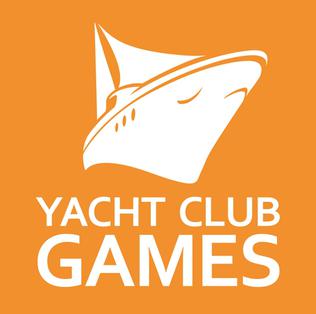
Yacht Club Games, LLC is an American independent video game development studio and publisher founded in 2011 by former WayForward Technologies director Sean Velasco. The company announced their first title, Shovel Knight, on March 14, 2013, and released it on June 26, 2014, after a successful Kickstarter campaign. In 2016, the company announced that it would start publishing games from other companies, and that their first published game would be Azure Striker Gunvolt: Striker Pack, a compilation containing Azure Striker Gunvolt and Azure Striker Gunvolt 2, which was released later that year. Their second published title was Cyber Shadow, a game developed by Mechanical Head Studios, which was released in 2021. In February 2022, the company announced their second original title, Mina the Hollower.
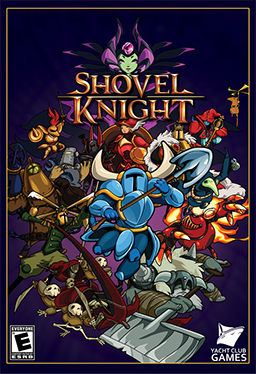
Shovel Knight is a platform video game developed and published by Yacht Club Games. Development was crowdfunded and the game was released for Nintendo 3DS, Wii U, and Windows in June 2014. It was ported to OS X and Linux in September 2014, PlayStation 3, PlayStation 4, PlayStation Vita, and Xbox One in April 2015, Amazon Fire TV in September 2015, and Nintendo Switch in March 2017. Shovel Knight is inspired by gameplay and graphics of platformer games developed for the Nintendo Entertainment System.
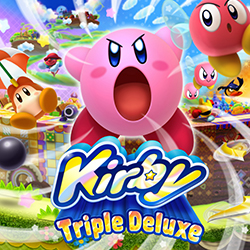
Kirby: Triple Deluxe is the thirteenth platform and tenth mainline installment of the Kirby video game series, developed by HAL Laboratory and published by Nintendo for the Nintendo 3DS. The game was released in Japan on January 11, 2014, in North America on May 2, 2014, in Europe on May 16, 2014, and in Australia on May 17, 2014. The game follows Kirby as he embarks on a journey through six worlds to rescue King Dedede from Taranza.

Metroidvania is a sub-genre of action-adventure games and/or platformers focused on guided non-linearity and utility-gated exploration and progression. The term is a portmanteau of the names of the video game series Metroid and Castlevania, based on the template from Metroid (1986), Castlevania II (1987), Super Metroid (1994), and Castlevania: Symphony of the Night (1997).

Runbow is a platform racing video game made for the Wii U and later ported to Microsoft Windows, New Nintendo 3DS, Xbox One, PlayStation 4, and Nintendo Switch. Runbow was developed by independent video game developer 13AM Games as their debut title, releasing it on 27 August 2015 in North America, 3 September 2015 in Europe, and 23 October 2015 in Australasia. The game was released in Japan on 25 November 2015.
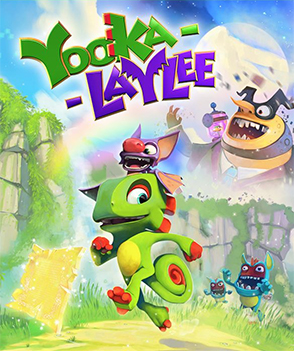
Yooka-Laylee is a 2017 platform game published by Team17 in for Windows, macOS, Linux, PlayStation 4, Xbox One, and Nintendo Switch, followed by a version for Amazon Luna in October 2020. Developed by Playtonic Games, a group of former key personnel from Rare, Yooka-Laylee is a spiritual successor to the Banjo-Kazooie series released for the Nintendo 64 nearly 20 years prior. After years of planning to develop a new game, Playtonic Games initiated a Kickstarter campaign that attracted significant media coverage and raised a record-breaking sum of over £2 million. The game follows chameleon Yooka and bat Laylee on their quest to retrieve a magical book from an evil corporation.
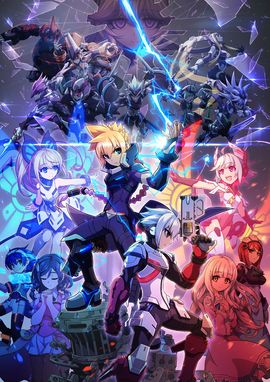
Azure Striker Gunvolt 2, known as Armed Blue: Gunvolt Sou in Japan, is a 2D side-scrolling action-platform video game developed and published by Inti Creates for the Nintendo 3DS. The sequel to Azure Striker Gunvolt, it was released in Japan on August 25, 2016 and worldwide on September 29, 2016. A compilation containing the game and its predecessor, titled Azure Striker Gunvolt: Striker Pack, was also available at retail in Japan and North America. Striker Pack was later released for Nintendo Switch on August 31, 2017 and PlayStation 4 on April 23, 2020. The standalone game was ported to Windows on June 22, 2020 and was released for Xbox One and Xbox Series X/S on July 14, 2022. A sequel, Azure Striker Gunvolt 3 was released in 2022 for Nintendo Switch, Xbox One, Xbox Series X/S, PlayStation 4, PlayStation 5, and Windows.

Celeste is a 2018 platform game developed and published by indie studio Maddy Makes Games. The player controls Madeline, a young woman with anxiety and depression who aims to climb Celeste Mountain. During her climb, she encounters several characters, including Part of You a personification of her self-doubt who attempts to stop her from climbing the mountain.

Dead Cells is a 2018 roguelike-Metroidvania game developed by Motion Twin and Evil Empire, and published by Motion Twin. The player takes the role of an amorphous creature called the Prisoner. As the Prisoner, the player must fight their way out of a diseased island in order to slay the island's King. The player gains weapons, treasure and other tools through exploration of the procedurally-generated levels. Dead Cells features a permadeath system, causing the player to lose all items and other abilities upon dying. A currency called Cells can be collected from defeated enemies, allowing the player to purchase permanent upgrades.

The Messenger is a 2018 action-platform game created by indie developer Sabotage Studio and published by Devolver Digital. The player controls the eponymous ninja, who is appointed by a great hero to deliver a scroll. As the Messenger explores levels and defeats enemies, he gains a currency called Time Shards used to purchase useful upgrades and abilities. The game begins as a linear adventure featuring elements of time travel, with the audio and visuals changing from an 8-bit style to 16-bit to represent the ninja's journey from the past to the future. In the second half, The Messenger becomes a Metroidvania-style game where the player revisits previous levels to find key items.

Just Shapes & Beats is an action rhythm video game developed and published by Canadian indie team Berzerk Studio. It was released on May 31, 2018, for Windows and Nintendo Switch, February 24, 2019, for macOS and Linux, May 10, 2019, for PlayStation 4 in the US, and May 30, 2019 for PlayStation 4 in Europe, Russia, and Australia. It was also released on June 30, 2020, for Stadia, and on May 31, 2022, for Xbox One and Xbox Series X/S. In this game, players move a colored shape to the beat of background music and dodge pink shapes.
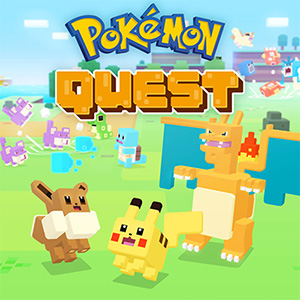
Pokémon Quest is a free-to-play action-adventure game in the Pokémon series developed by Game Freak. It was released for the Nintendo Switch in May 2018 and for Android and iOS in June 2018. Within a week of its release, it had reached over 7.5 million downloads.

Cyber Shadow is a side-scrolling action-platform game developed by Finnish indie studio Mechanical Head Studios and published by Yacht Club Games. Using an 8-bit aesthetic, the game follows a cybernetic ninja named Shadow who sets out to rescue his clan in a world overrun by machines.

Shovel Knight Pocket Dungeon is a roguelike puzzle game co-developed by Vine and Yacht Club Games, and published by Yacht Club Games. A spin-off of the platform game Shovel Knight, the player takes control of the namesake adventurer as he becomes trapped within a magical artifact, the Pocket Dungeon, and is forced to fight his way out while battling other knights who befell the same fate.
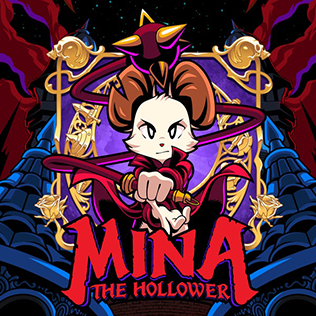
Mina the Hollower is an upcoming action-adventure game by Yacht Club Games. It is planned for release on Windows, macOS and Linux. The game revolves around Mina, a skilled inventor and "Hollower" who travels to Tenebrous Isle to discover why the Spark Generators she invented to power the island have gone out.

Shovel Knight Dig is a 2022 roguelite platform game developed by Nitrome and Yacht Club Games. It is an entry in the Shovel Knight franchise and a prequel to the original game. The player controls the protagonist Shovel Knight as he fights enemies and collects treasure while descending down a hole to recover his stolen treasure bag. When the player dies, they lose all obtained upgrades, returning to the surface with a fraction of the treasure they collected while playing. At the surface, they can spend treasure on a variety of items that make gameplay easier.

Shovel Knight: King of Cards is a downloadable content (DLC) expansion for the 2014 platform game Shovel Knight, developed and published by Yacht Club Games. The player takes control of a dandy named King Knight as he goes on a quest to win a card game and be awarded the title "King of Cards". King Knight attacks enemies by charging towards them, and is flung into the air after making contact with a surface or enemy. Gameplay is similar to the original Shovel Knight, but features shorter levels and several new locations. Aside from the platforming, the player can engage in a card minigame called Joustus where they must strategically place cards on a board to ensure they occupy certain spaces.
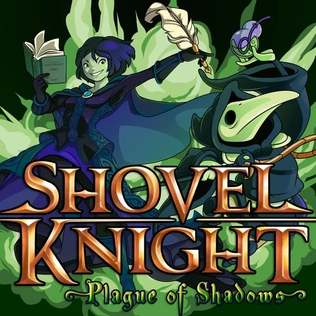
Shovel Knight: Plague of Shadows is a downloadable content (DLC) expansion for the 2014 platform game Shovel Knight, developed and published by Yacht Club Games. The player takes control of Plague Knight, an alchemist on a journey to create the ultimate potion. Plague Knight attacks by throwing alchemical bombs, and has the ability to double jump and perform a more powerful "burst jump" that sends him forward through the air. Gameplay is similar to the original Shovel Knight but features a new story and alterations to the levels to account for Plague Knight's movement.
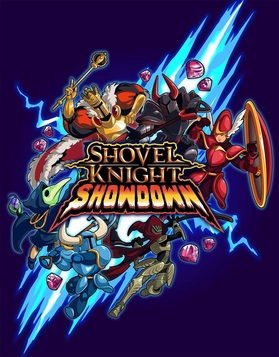
Shovel Knight Showdown is a 2019 fighting game developed and published by Yacht Club Games. An add-on to the platform game Shovel Knight, players take control of twenty characters with various movesets and fighting styles. The game features several modes, such as "Treasure Clash", where players battle one another to collect the most gems that appear on a stage, to a free for all setting where players engage in a battle to the death. In the story mode, a single player battles against AI-controlled opponents across several stages before facing a boss. Completing this mode with each fighter allows the player to unlock new stages and characters.





















